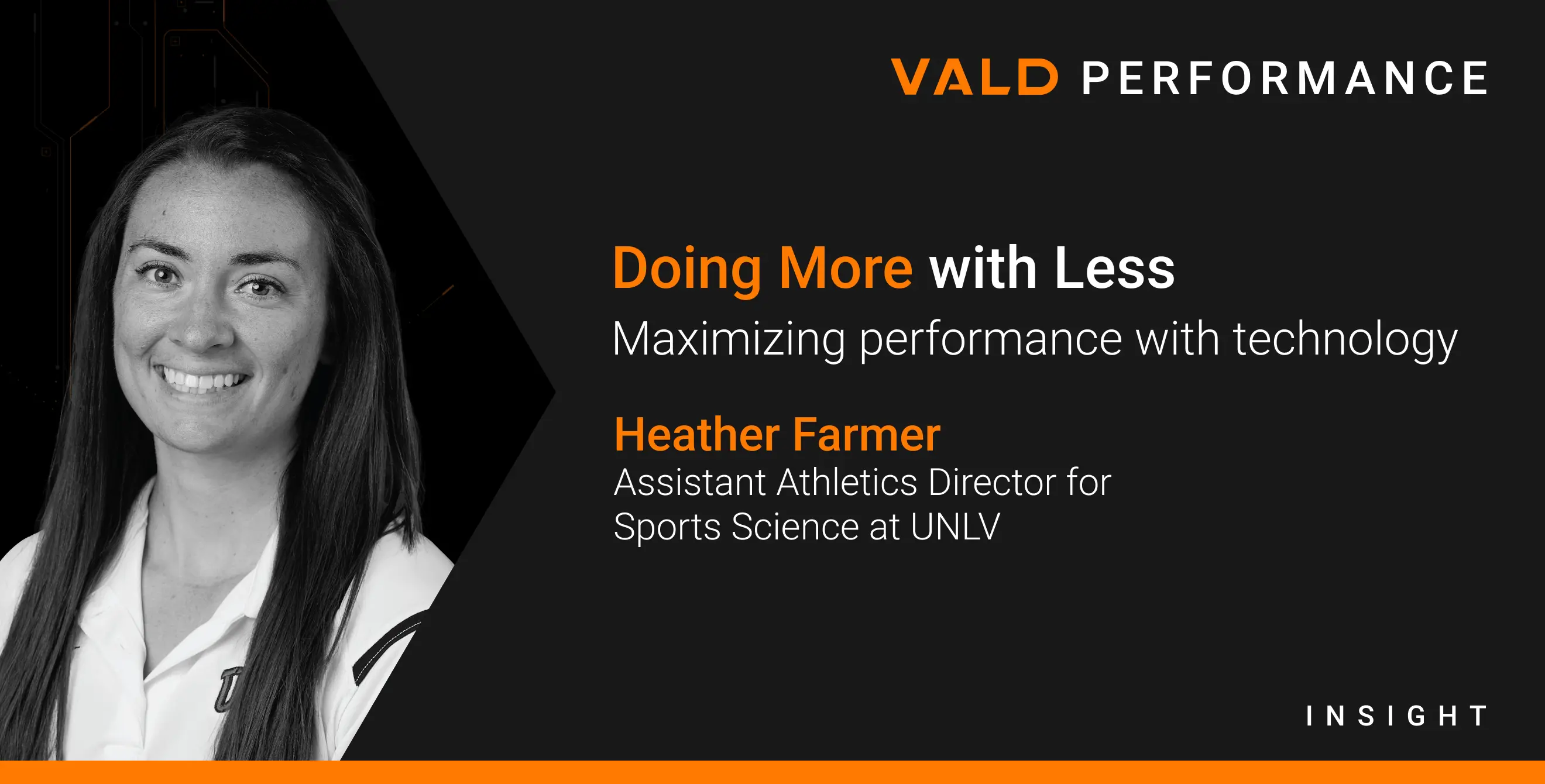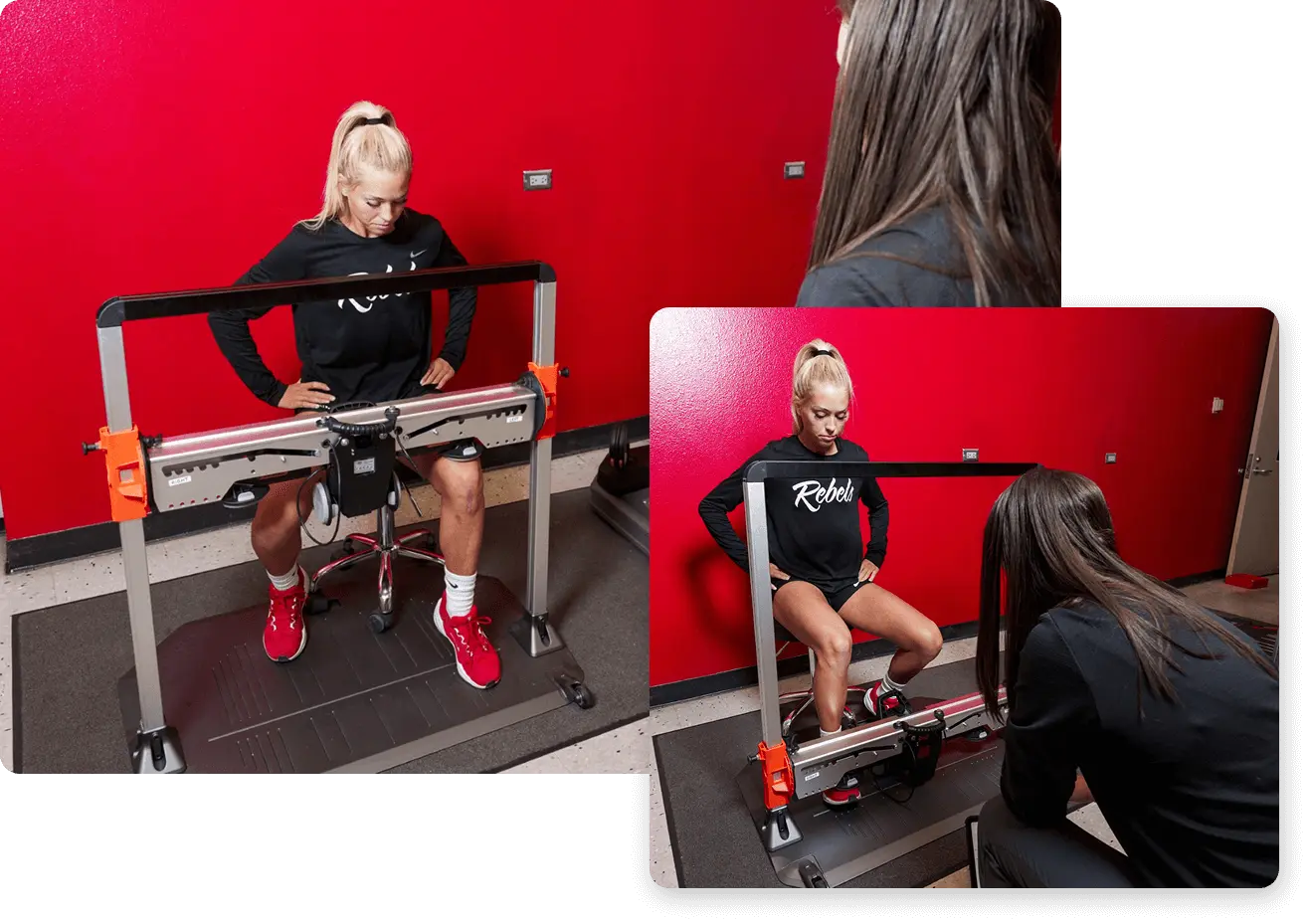Doing More with Less: Maximizing performance with technology
Available in:
EN
Ahead of her presentation at VALD’s Return to Performance event in Phoenix, Arizona, Heather Farmer, Assistant Athletics Director for Sports Science at the University of Nevada, Las Vegas (UNLV), shares how her department uses VALD technology, including ForceFrame, ForceDecks and NordBord, to deliver maximum value across teams, disciplines and budgets.
From return-to-play to readiness monitoring, Heather outlines the operational strategies and practical wins that have helped her team stretch technology across the full spectrum of athlete care.

The role of a Sport Science Director can vary greatly – what do your day-to-day responsibilities look like?
My primary objective is focused on bringing departments together – strength, rehab, nutrition and mental performance – around a shared mission: taking care of the individual athlete. As an interdisciplinary team, we want to move away from the often-siloed disciplines and become a fully collaborative high-performance unit.
…we integrate technology and workflows that support each department’s role while aligning around shared data and goals.
Sample models comparing multidisciplinary and interdisciplinary care teams.
To make that possible, we integrate technology and workflows that support each department’s role while aligning around shared data and goals. On a practical level, that means everything from overseeing training load monitoring to running jump tests on ForceDecks and periodic NordBord diagnostics to support readiness and guide weight room programming.
My intern team monitors practices in real time to provide on-field feedback for coaches and sports medicine staff, while the sport science team handles diagnostic testing both in the lab and on the field.
What does the UNLV interdisciplinary team look like in action?
Every interdisciplinary team will look different based on the skills and experiences each practitioner brings to the table and the demands of each sport. For example, my assistant, Emily, and I oversee sport science for every sport on campus, but our sport science responsibilities can look vastly different from team to team.
When onboarding teams that are new to our integration process, we rely heavily on our collaborative coaching staff. By leveraging skills coaches, strength and conditioning staff and interns, our sport science monitoring strategies become streamlined by having everyone on the same page.

A UNLV athlete performing a countermovement jump (CMJ) on ForceDecks.
What barriers in testing have you faced and how have you overcome them?
As a two-person department, my assistant and I leverage our communication skills and knowledge of the staff to apply technology in the most effective way. Although we’re the ones who receive all the data and analyze it, our colleagues are trained in data collection and testing batteries for specific assessments.
With all team members, our first step is a full walkthrough of the technology we use. I show them each device we have access to, then give a basic rundown of how to navigate assessments, dashboards and where to find data. This year, I scheduled 20-minute onboarding sessions with every staff member to ensure that everyone is on the same page and remove any barriers between sport science and other domains.
…all team members [get] a full walkthrough of the technology…[they learn] how to navigate assessments, dashboards and where to find the data.
My team handles most of the testing, but in cases like volleyball, where testing times are often constrained, we rely on support from other departments. One of our sports medicine leads is fantastic – she’s great with ForceFrame assessments and steps in when we need extra hands. These one-off training moments happen when needed, but the key is that everyone knows how to navigate the system and find the information.

A UNLV athlete undergoing lower-leg profiling assessment with ForceFrame.
We also hold weekly high-performance team meetings. Everyone – coaches, medical and performance staff – sits around the table and discusses results, trends and testing takeaways. This gives people a chance to hear the language, ask questions and start applying it in their own performance pillar. We want team members to challenge ideas, bring new perspectives and ultimately grow together.
…[during] weekly high-performance team meetings…coaches, medical and performance [sit] around the table and [discuss] results, trends and testing takeaways.
How often do you coordinate profiling and monitoring assessments with the athletes?
Aside from the weekly and biweekly assessments that we use for long-term rehabs and athletes returning to play, we break out our larger-scale strength diagnostic assessments three times per semester:
- Preseason: These assessments are always our most thorough. We perform CMJs and isometric mid-thigh pulls (IMTPs) on ForceDecks, eccentric and isometric assessments on NordBord and hip assessments on ForceFrame.
- Midseason: These assessments are quick check-ins to help confirm whether strength qualities have been maintained, improved or worsened. We use similar tests in preseason, focusing on areas where an athlete previously scored below target.
- End of Season: As the season nears the end, we test again for two main reasons:
- If there is a post-season (playoff), we know exactly how to train and manage any injuries if they come up.
- We can learn how the training we implemented, and the sport demands influenced their performance qualities, so we can continue to improve year after year.
CMJ historical data displayed in VALD Hub showing trends in performance.
Our daily operations vary by season, but we consistently integrate technology across several areas – using force plates in the weight room, conducting return-to-play assessments in sports medicine, and working toward incorporating basic health metrics (e.g., body weight) into nutrition planning.
- Force Plate Testing: ForceDecks are used both for readiness monitoring and diagnostic testing. If something is flagged, our goal is to make the reports as accessible and immediate as possible. There’s no use in monitoring if we let a coach know about a dip in performance three days after the fact.
Different monitoring reports on VALD Hub displaying data trends for quick performance flagging and coach feedback.
- Return to Play: Our current goal is to have rehab plans mapped out for medical and performance staff ahead of time. That way, we can set benchmarks and criteria to ensure the technology is integrated effectively.
- Health and Nutrition: A huge benefit to ForceDecks is the weighing period prior to testing. Here, we can also monitor the basics of bodyweight changes. If an athlete has certain composition goals with our nutrition team, ForceDecks testing helps to have a somewhat “invisible monitoring” strategy for capturing athletes’ weights.
How do you keep departments aligned around data and metrics?
At the beginning and end of each academic year, we bring the whole performance team together to agree on the following:
- What metrics matter for each team.
- How each department wants to use the data.
- What trends from last year influence this year’s priorities (e.g., if we had a high number of hamstring injuries, we focus there).
We also meet weekly as a high-performance team to talk through current athletes, rehab plans and upcoming testing. It’s how we build a shared understanding across the team, making sure we’re not just tracking data but aligning on what it means and how it informs decision-making.
Where do you see technology adoption going wrong?
A huge pet peeve of mine is when people adopt technology just because everyone else is doing it. We don’t invest in tools because they look good or because someone else has them. We invest in tools that allow our athletes to stay healthier, perform better and give us the results we need on the court.
We don’t invest in tools…because someone else has them. We invest in tools that allow our athletes to stay healthier, perform better and give us the results we need…
We start by asking every coach and performance staff member: What problem are you trying to solve? Then we reverse-engineer from there:
- Strength and conditioning coaches use force plates to monitor strength and asymmetry.
- Coaches use them to help track recovery and performance trends.
- Sports medicine uses them for return-to-play and prehab.
- Nutrition uses force plates to monitor weight trends discretely – we even weigh athletes through the plates without them knowing to avoid adding body image stress.
Recently, we used live jump feedback during a session with a sports psych and an athlete struggling with fear in rehab. After working on some mental training, we showed her how her jump numbers improved in real-time, which became a breakthrough moment for her during rehab.
What’s next for you and UNLV’s sport science department?
We’re aiming to launch a PhD program in sport science. There’s still a shortage of programs that offer both research and practical application. We want to be that bridge – to take students from textbooks to hands-on testing, helping them understand how science applies to real athletes in real time.
[With] a shortage of programs that offer both research and practical application. We want to be that bridge – to take students from textbooks to hands-on testing…
To support that kind of practical learning – and make sure our resources go as far as possible – we’re also being strategic with our budget. Like many schools, we don’t have endless resources. So, we’re focused on tech that serves multiple departments, answers the most questions and puts the least amount of stress on the athlete.
Catch Heather at VALD’s upcoming Return to Performance Conference in Arizona as she shares more on building scalable, integrated sport science systems that prioritize athlete care and cross-discipline collaboration. If you have not signed up for the event yet, you can register here.

To see how VALD technology can support your team's performance and recovery workflows, get in touch with our team.
